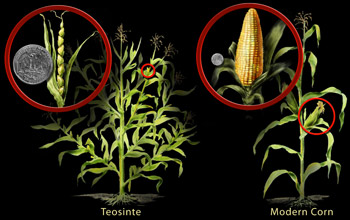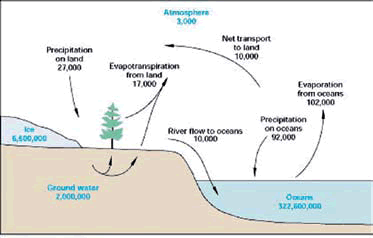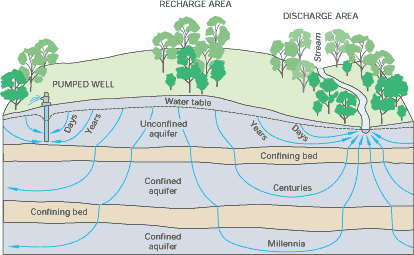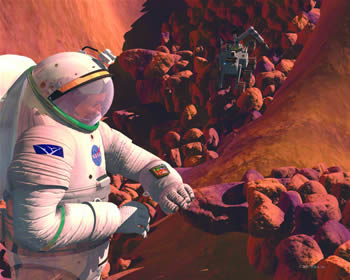NAWAPA from the Standpoint
of Biospheric Development
by Sky Shields, Oyang Teng, Michelle Lerner, Cody Jones, Ben Deniston
August 2010
This article appears in the August 13, 2010 issue of Executive Intelligence Review and is reprinted with permission.
|
Teosinte represents the state of corn at the time man first encountered it in the wild. Only a very small portion of the bushy plant contained the nutrients and digestible material that make corn the staple it is today. The highly nutritious, and energy-efficient food that we now call corn is entirely a creation of early man’s projects in biological engineering and, like the similarly human-engineered modern cow, will not survive outside of human care. |
The current crisis is not a financial one, or even a physical one, in the simplest sense. We are not facing a lack of finances, or a lack of resources. We are facing a crisis of human culture, of which the current U.S. President and his predecessor are merely exemplary. It is time that we analyzed more deeply the roots of the erroneous thinking which have led us into this current disaster, in order that we might avert it in the only way possible: by turning our sights once again towards humanity's future, and returning to the cultural-philosophical roots of a true science of physical economy.
When man "builds infrastructure," he is not simply placing some object called infrastructure into an empty box. He is actually reorganizing the physical space-time of the Biosphere, as a system, by transforming and redirecting the biogenic flows through the Biosphere, allowing it to attain higher and higher levels of energy flux density. The simplest example of this, is the introduction of farming and animal husbandry: The apples, corn, and livestock of today are far different, and far more efficient, in terms of energy density, than their wild counterparts which reflect the state in which man first encountered them.
|
|
Photosynthesis, which converts the diffuse energy of incident sunlight into the concentrated form of chemical bonds, creates both the difficult-to-digest cellulose of plant stems, as well as the easily accessible energy stores of carbohydrates and other organic molecules. This process is a part of what Russian-Ukrainian biogeochemist V.I. Vernadsky called the biogenic migration of atoms—the continuous flow of matter through the Biosphere as the result of living processes, creating higher and higher levels of organization in the secreted fossil materials. Man's action on apples, corn, and livestock, for example, increases the ratio of usable carbohydrates, lipids, and proteins to the expensive (in terms of energy), but relatively useless (for consumption) cellulose of the plant's structural components.
Ultimately, the survival of the human species will depend on man's ability to not only organize these flows and increase their efficiency, but also, to create, from scratch, the environment of biogenic flows which he requires in order to live outside of Earth's atmosphere, and to colonize our Solar System and beyond.
The North American Water and Power Alliance (NAWAPA)[1] program will be among the first of man's projects to willfully redirect those larger processes determining the further evolution of the Biosphere, as a whole, serving as the reference point for such challenges as establishing permanent settlements on other planets, such as Mars. Again, this will be achieved through further understanding and redirecting these biogenic flows, but now, on a much grander and more fundamental scale.
This biogenic migration of atoms is more than a mere flow of material "within" the Biosphere. It constitutes the very structure of the Biosphere, and governs the nature of Earth's interaction with phenomena outside of the Earth's atmosphere, such as solar and cosmic radiation.
Earth’s Atmosphere
Our planet is sometimes unimaginatively pictured as a rocky sphere to which a thin layer of gas tenuously clings amidst the vacuum of space. Far from that bleak prospect, the Earth’s surface represents a particularly intense region of transformation of the cosmic radiation which permeates all of space. In our neighborhood, the vast majority of this radiation is emitted by the Sun, which produces a large spectrum of electromagnetic frequencies, as well as a constant stream of electrically charged plasma called the Solar wind. The Solar wind, guided by the Sun’s magnetic field, is involved in a constant interaction with the plasma that constitutes the upper regions of the Earth’s atmosphere and Earth’s own, constantly changing, magnetic field. This complex interaction produces highly structured phenomena such as the Van Allen radiation belts and the aurorae, while the ionosphere itself produces electromagnetic radiation in the low frequency range.
The relative strength of the Sun and Earth’s magnetic fields also modulates the influx of galactic cosmic rays, which change the climate through cloud formation, and acts directly on the evolution of living organisms over longer periods of time. It has also been documented that subtle fluctuations in the Earth’s magnetic field, in part induced by its interactions with the Sun, directly influence the behavior and vital activity of living organisms and is likely a factor in their evolution. But, it is life itself which produced the ionosphere, through its creation of the atmosphere.
Several recent studies also point to the possibility of life’s direct role in the creation of the geomagnetic field, possibly through the movement of ocean currents, and through the influence of water on plate tectonics, which could affect heat convection of the hypothesized dynamo beneath Earth’s crust. Whether this is the actual mechanism or not, it is in fact the case that the peculiar character of Earth’s magnetic field is associated with its uniqueness as a bearer of living matter in the Solar System.
Thus, in sum, it is safe to say that weather, in space and on Earth, is a product of living processes.
The Creation of Earth's Atmosphere
To take a useful example: The creation of Earth's oxygen atmosphere by life not only caused a massive change in species on the face of the planet—rendering the vast majority of then-existing life forms extinct, while paving the way for more complex, oxygen-breathing life forms—it also changed the Biosphere's interaction with the Sun's electromagnetic radiation (specifically in the "ultraviolet wave range"), creating a higher degree of structure within the Biosphere—the ozone layer—which, in turn, further moderates which frequencies of electromagnetic radiation would be allowed to enter Earth's developing Biosphere to affect planetary evolution.
This biogenic migration of atoms also caused the development of the ionosphere, the highly energetic zone which, by its interaction with the solar wind and Earth's magnetic field, is responsible for the creation of the aurorae, and which can at times act as a massive particle accelerator, determining what types of cosmic radiation will be fed down onto the Earth's surface. Some of this radiation would be involved in producing the cloud cover which moderates the Earth's temperature and produces precipitation.[2]
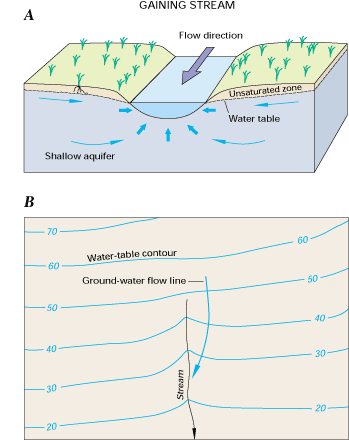 |
Source: USGS Surface water and ground water are not two distinct phenomena. Rather, they form a single, complex flow of water and associated minerals, characterized by abrupt discontinuities which delineate sharp changes in flow intensity and direction. A. A flowing body of water, gaining volume all along its length from a connected aquifer. B. The gradient associated with an aquifer’s flow lines, compared to the direction of the flowing surface water, shows whether the stream is replenishing the aquifer or vice versa. |
Certain aspects of this process of biogenic migration of atoms are popularly broken down, for ease of understanding, into several oversimplified cycles: the "water cycle," "nitrogen cycle," "carbon cycle," etc. At low resolution, these do, in fact, appear as simple cycles, but when viewed more closely, they form an interconnected network, a system, whose causal interrelations are impossible to represent linearly. Changes in the nitrogen concentration of soils, caused by perturbations in the nitrogen cycle, change the rate of carbon fixation in plant life, perturbing the carbon cycle, which in turn changes the rate of photosynthesis, perturbing the oxygen and water cycles, which in turn perturb the nitrogen cycle, and other biogenic flows of atoms, etc., etc.
Even within a single one of these so-called cycles, the amount of complexity quickly reaches a point where the description requires a systems approach—a tensor description—particularly when we wish to discuss the conscious manipulation of such a system.
|
An image of an interconnected system of ground water and surface water. |
Taking water as an example: In first approximation, at the lowest resolution, we can describe the water cycle as a simple process, beginning with sunlight's effect on the ocean surface, causing evaporation. This evaporated water rises into the atmosphere; some of it migrates over land and falls as precipitation. This precipitated water then makes its way, over time, back into the ocean, by way of streams and rivers.
Upon closer examination, this process really consists of many interconnected sub-cycles, where water plays its most important role, in facilitating the growth of plants. In this process, there is no clear beginning, nor are there any simple linear or cyclical relationships. Plants consume both water and sunlight, using them to produce oxygen, and to fix CO2 into energy-dense organic molecules. The moisture which these plants release in transpiration then rises up to become cloud cover, feeding and enhancing the precipitation which had permitted their growth originally.
If the vegetation becomes dense enough, this additional atmospheric moisture is enough to change weather patterns, alter the landscape, and reshape the course of rivers. At various stages of this process, large amounts of water enter the soil, to either be evaporated again into rainfall, or to be sucked deep down into the groundwater stores which form a continuous system of exchange with the above-ground lakes and rivers.
The result of this is that, globally, the same water falls an average of 2.7 times[3] on land before returning to the sea, and the rate is obviously higher in areas of dense vegetation. Further, as the groundcover and soil moisture change, so does the reflectivity of certain parts of the Earth's surface, which, in turn, transforms how sunlight is absorbed and changes its effects on temperature and evaporation.
The number and types of interrelations are vast, but perfectly comprehensible to the human mind, when aided by the proper conceptual tools. In fact, their thorough comprehension is the destiny of the human species, since the mastery—and replication, in an improved form—of their complex interrelations will be necessary in order for man to achieve his destiny of colonizing interplanetary and interstellar space. Already today, spacecraft designers must attempt to recreate portions of the oxygen, carbon, and water cycles in miniature, in order to maintain crews on their trips.[4] The same process, at much higher levels of complexity and efficiency, and combined with a deeper understanding of the role of cosmic radiation and other electromagnetic and gravitational phenomena, in the maintenance and evolution of life on Earth, will be required for the establishment of permanent settlements on the Moon, Mars, and beyond. Projects like NAWAPA will bring such goals—necessary for the continued survival of the human species—out of the realm of science fiction, and within reach of humankind.
The introduction of irrigation, and the consequent agricultural development, increases the amount of transpiration in a given area, creating more, sustained sub-cycles of rainfall, and generating rainfall which previously may not have existed.
|
Rainfall map of the world. Note the disparity in the amount of rainfall along the Pacific Coast of the United States. |
What Does This Mean for NAWAPA?
|
The North American Water and Power Alliance (NAWAPA) is a continental development project, proposed by the Ralph M. Parsons Company in 1964. Its implementation would have marked a new phase in the evolution of the Biosphere and Noösphere. The failure to implement it coincided with the beginning of a decades-long collapse of infrastructure and physical productivity worldwide, which now threatens the very existence of human civilization. |
In this case, we are taking a portion of the hydrological cycle involving the western region of North America, which currently includes relatively few sub-cycles, and connecting it into a Noöspheric system of much greater complexity. Water that evaporates off the surface of the Pacific Ocean tends preferentially to travel up the coastline as cloud cover, and deposit itself in northern regions as solid ice and rivers.
A large percentage of this freshwater then runs directly into the ocean off the coast of Alaska and North America, never taking part in any biospheric sub-cycles on land. Meanwhile, the southern desert area of the west—the Great American Desert—remains dry and barren (see NASA animation of clouds circulating up the coast at: http://svs.gsfc.nasa.gov/vis/a000000/ a003600/a003645/index.html).
To get an idea of this quantitatively:
The total amount of water evapotranspired from land and ocean amounts to 57,600 and 351,400 million acre feet per year (MAFY: the amount of water contained on 1 million acres of land, at a depth of 1 foot), respectively,[5] for a total of 409,000 MAFy.[6] Twenty-five percent of that, or 86,700 MAFY,[7] falls back onto the land as rain or snowfall, while the rest is rained directly back into the ocean. At any given moment, there are 12,600 MAF of water in the atmosphere, 3,600 of which is over land. Approximately 2,800 MAFY fall within just the Alaskan and Canadian catchment basin to be utilized by NAWAPA, an amount equivalent to more than half the total precipitation of the entire continental United States! This produces 8-900 MAFY[8] of run-off into the Pacific and Arctic Oceans. This quantity is lost to the productive processes of the Biosphere, never taking part in photosynthesis, or any other biospheric process during its time on land. This is a continuous cycle, constantly replenished, although, in parts, it is terribly inefficient.
California’s Central Valley
In California, some of the country’s most productive agricultural land (not to mention, America’s second-largest metropolitan area, Los Angeles) is spread over what amounts to a desert. This is made possible by a massive infrastructure network which diverts the flow of the Colorado River and northern Sierra Nevada mountain runoff through a series of dams, reservoirs, pumps, and canals, for delivery of freshwater into the arid central and southern regions of the state. At the time it was initiated by Franklin Roosevelt in the 1930s, the Central Valley Project (CVP) was biospheric engineering on a grand scale, which was expanded, beginning in the late 1950s, under Gov. Pat Brown’s State Water Project (SWP) initiative. A recent study showed that irrigation in the arid Central Valley has led to a decline in average daytime temperatures between 2-3° C. Today, the CVP and the SWP together provide an average of 10 million acre-feet/yr (12 km3/yr), representing more than 25% of the state’s total freshwater consumption. California’s yearly share of NAWAPA water would more than double this amount.
Thus, it becomes clear that, contrary to popular misconceptions and outright lies, the water to be used by NAWAPA is not some stash, which will be run down over time, nor is it water which otherwise would be used for other purposes. NAWAPA is the harnessing and improvement of this natural, global cycle and, because of this, will be capable of not only providing freshwater to the western U.S. and northern Mexico for perpetuity; experience has shown that it will also permanently transform the climate in these areas as a result, lowering the temperature and increasing rainfall.
NAWAPA will transform this cycle, drawing a portion (160 MAFY, or 20%) of what would otherwise immediately become run-off water, into a system of already existing rivers and newly made canals. As it travels, the water will replenish groundwater stores and take part in greening large swaths of the Great American Desert. This will extend the time this water spends on land by orders of magnitude, as well as increasing the frequency of its circulation during that stay.[9]
Now, what will be the effect of the increased plant transpiration in the 21-50 million acres of new farmland and forests created as a result of the NAWAPA project? This will be up to double the current irrigable acreage west of the Mississippi. For the United States, this amounts to a strip of newly irrigable land 1,800 miles long and 35 miles wide—nearly four times the size of California's Central Valley.
Again, the careful selection of regions of farmland, but also areas of new, highly organized and maintained forests, where once there was desert, will increase the overall soil moisture, as well as increasing the amount of overall evapotranspiration over land. This will lead to increased rainfall, and, if carefully structured, new and beneficial downwind rain and weather patterns. The water introduced by NAWAPA will be used not once, but multiple times, as it makes its way through innumerable smaller sub-cycles, falling multiple times as rainfall over land, before finally making its way back to the sea, to someday, eventually, make its way back to Alaska to begin the entire cycle once again. Only now, among its activities, will be included a plethora of industrial and other uses. This same water might someday be the freshwater used to hydrate the first manned crew traveling to Mars!
Chlorophyll
As an aside, it ought to be clear from what has been said so far that, due to the centrality of photosynthesis in this process, land which might otherwise be wasted on inefficient solar panels ought instead to be used to grow green plants—the only efficient utilizers of solar radiation. These massive areas of new greenery, carefully selected as to quantity, quality, and location, will fuel the process of transformation, and beautify the hundreds of new cities which will be built to maintain this process.
A Complex System of Interweaving Cycles
In this way, NAWAPA can be seen as a transformation of a complex system of interweaving cycles, increasing the complexity and efficiency of the overall process, while not subtracting anything. Self-conscious use of the new hydrological sub-cycles will permit transformations of the several other cycles mentioned above. The increase of the forested area of North America will produce a larger, more efficient CO2 sink, increasing the rate of the carbon cycle on land. We may even discover that the available CO2 is too little for our purposes! To fuel that carbon cycling, we will need to—among other things—increase the amount of available nitrogen in the soils, allowing for the growth of these photosynthesizing plants.
The available water will be used to replenish groundwater stores such as the Ogallala Aquifer, reduce the mineral contamination of water retrieved from the Colorado River, and clean the soil of farmland in the Midwest, as well as flushing and replenishing the Great Lakes. This same process will be the model for the similar development projects to be deployed in Mexico, Africa, Central Asia, Southwest Asia, Siberia, Australia, and similar regions worldwide, thus further extending man's conscious management of the Biosphere as a whole. Afterwards, this process can and must be extended to include more directly the development of Earth's oceans.
The Moon-Mars Project
|
Shown: an artist’s rendering of an astronaut collecting samples on a future mission to Mars. |
As has been discussed, understanding the Biosphere includes understanding the intimately connected set of relationships among terrestrial and cosmic phenomena, such as gravitation, the geo-magnetic field, solar radiation, as well as cosmic radiation. On Mars, the magnitude and state of these various elements is very much different. For example, the gravitational effect is one-third that of the Earth, and the magnetic field is faint and dispersed, which, along with other factors, figures in the absence of a substantial atmosphere on Mars, all of which are part of a differing dynamic relationship with the Sun itself. Thus, many factors which we heretofore had taken for granted on Earth, become existential challenges when orienting towards sustaining life on Mars, not to mention the first step in that process of colonization: that of the industrialization of Earth’s Moon. This must be done for the purpose of, among other things, utilizing the low-gravity environment for building the ships to take us to Mars, as well as for the mining of the Helium-3, abundant in the lunar soil, to be used as the fuel for the yet-to-be-developed fusion powered rockets, the only fuel capable of achieving one-Earth-gravity equivalent acceleration—an acceleration requirement necessary to deliver humans to Mars in a timely (4-7 days) and safe manner. Consequently, in understanding how we come to gain mastery over the organization of Earth’s Biosphere, we gain insight into exactly what parameters and requirements are necessary to create superior life-supporting systems beyond it.
It is significant to note that, despite the seemingly colossal scale of all of this, we are discussing relatively tiny portions of incredibly large numbers. Only about 1/billionth of the radiant energy released by our Sun falls on the Earth, at any given moment. Not more than 50% of this tiny bit of radiation fuels the processes of evaporation, transpiration, and photosynthesis, which latter drives the biogenic migration of atoms, producing—among all of the other things we have discussed—all of the rainfall and all of the flow in the rivers we are here discussing. In order to accomplish NAWAPA's goals, only about 20% of the runoff from the targeted Alaskan and Canadian rivers is required to be redirected. This runoff represents perhaps 1% of the total runoff of the Earth's crust, which itself is a small percentage of the total freshwater, 70% of which is locked up in snow or ice.
At any given moment, only about 1% of the total freshwater of the planet is "in play" in the near-surface Biosphere—only 1% of freshwater is directly accessible to living processes at or near the surface of the planet. But what occurs in that 1% drives the entire cycle, much in the same way as living matter—a tiny percentage of all of the matter in the Biosphere—drives the entire biogenic migration of atoms, reshaping Earth's crust and oceans, creating Earth's atmosphere, and governing the electromagnetic interaction with the universe as a whole. Man, in terms of his mass, represents a tiny portion of even this tiny amount of living matter. Yet man, by the power of his mind, is the only force in the universe deserving of the title "Co-Creator" of that universe—capable of understanding and improving the processes by which that universe was brought into being.
The Necessary Next Step
In this way it should become clear that NAWAPA is not merely a piece of interesting policy. It is the necessary next step in man's emergence from his civilizational adolescence. In order to accomplish this next step, a major cultural-political shift must occur, which will express the sharp rejection of the cultural and political turns of the last decades. NAWAPA alone will be a multi-generational project, requiring at least a quarter of a century for its completion. The expanded mission of developing the Solar System will require several generations more. This is the antidote to the no-future ennui of today's young adult generation, forging the cross-generation connection which separates our species—at its best moments—from the beasts.
|
|
Vernadsky and the Biosphere
Vladimir I. Vernadsky’s concept of the Biosphere contained nothing of the silly “equilibrium” that modern environmentalist idiots seek to ascribe to it. Rather, it was a dynamic and evolving system which formed the interface between the Earth and the energetic processes of interplanetary and interstellar space. The introduction of man shifted that dynamic system into a new state—that of the Noösphere—providing for levels of creative evolutionary development which were otherwise impossible, including the possibility of greening the deserts, and extending the Biosphere off of Earth’s surface. This scientific understanding of nature— as opposed to the primitive, superstitious notions pushed by the anti-human “green” movement— is indispensable for a true science of economics.
Like all great feats of human creativity, this is not a project designed for immediate consumption. This is a project designed to extend man's sense of self far beyond the confines of his sense perceptions and feelings of personal well-being, and connect him instead to generations which will continue his legacy long after his generation has left this Earth.
The cultural transformation required to accomplish a project of this scale, must include a repudiation of the past decades' policies of free trade, and a reinstatement of the kinds of controls over banking and financial policy which the Glass-Steagall standard represents. We must see a clear rejection of the anti-science, anti-progress, and anti-human policy represented by the recent decades' rise of green fascism.
Most importantly, we must demand the rejection of this current President, Obama, whose personal sense of identity, like his policies, lies in those very same failed cultural characteristics which have brought us to this point of collapse. Then, and only then, may we free ourselves for the real work to be done.
References:
Lyndon H. LaRouche, Jr., "Body or Mind?" (Pre-publication fragment; article to appear in an upcoming issue of EIR).
V.I. Vernadsky, The Biosphere (New York: Springer; 1997).
L.S. Kuchment, "The Hydrological Cycle and Human Impact on It," in "Water Resources Management," Encyclopedia of Life Support Systems, 2004.
R.W.A. Hutjes, "Biospheric Aspects of the Hydrological Cycle," Journal of Hydrology, Nos. 212-213 (1998), pp. 1-21.
N.W. Snyder, "Water from Alaska," speech to Fusion Energy Foundation conference on "A High Technology Policy for U.S. Reindustrialization," Los Angeles, 1980.
L. Gordon, "Land cover change and water vapour flows: learning from Australia," Phil. Trans. R. Soc. Lond. B (2003) 358, 1973-1984.
H.W. Ter Maat, "Meteorological impact assessment of possible large scale irrigation in Southwest Saudi Arabia," Global and Planetary Change, No. 54 (2006), pp. 183-201.
R. Bras, "Planet Water: Complexity and Organization in Earth Systems," James R. Killian, Jr. Faculty Achievement Award lecture, MIT, 2009.
T.C. Winter, J.W. Harvey, O.L. Franke, and W.M. Alley, "Ground Water and Surface Water: A Single Resource," U.S. Geological Survey Circular 1139, Denver, 1998.
[1] See "The Tennessee Valley Authority of the 21st Century," by The LPAC Basement Team, EIR, Aug. 6, 2010.
[2] One might, in fact, consider this entire process to be the creation of a sort of biospheric infrastructure, where biological fossils continually provide the conditions for more advanced creative processes.
[3] Lev S. Kuchment, "The Hydrological Cycle and Human Impact On It," in "Water Resources Management," Encyclopedia of Life Support Systems, 2004.
[4] As an example, take the limited example of water, oxygen, carbon, etc., recycling on the International Space Station.
[5] 71,000 km3/yr and 434,000 km3/yr, respectively.
[6] 505,000 km3/yr
[7] 107,000 km3/yr
[8] 990-1110 km3/yr
[9] It is important to note that here, again, it becomes clear that the concept of a "water cycle" is inadequate. Water which participates in photosynthesis ceases to be water, and is, instead, broken up into free oxygen, released as a gas, and hydrogen, which is fixed into organic molecules, thus feeding into two entirely different "cycles." Thus, although the overall quantity of water on the Earth may stay the same, it is not the case that this is always the "same" water.

